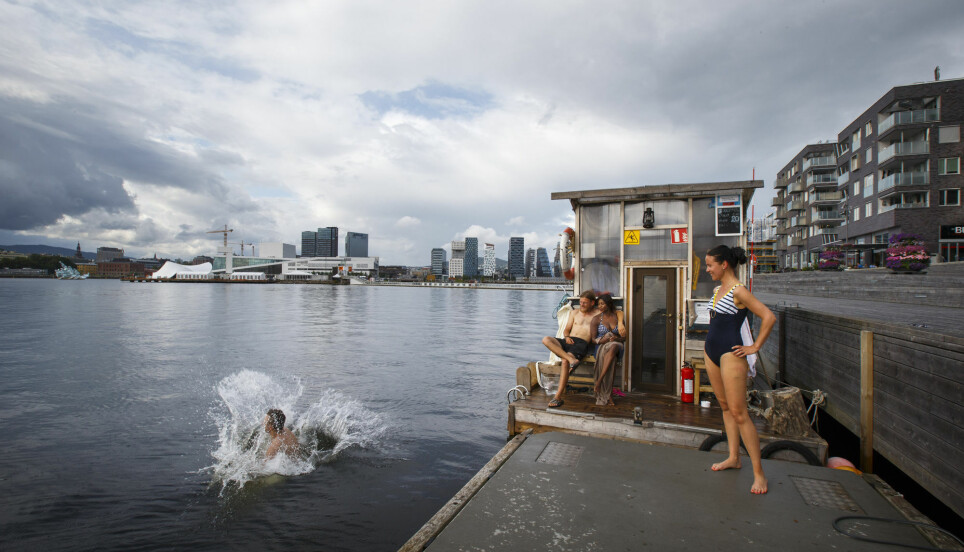
Low income workers and young people could end up fleeing the big cities. We need to rethink housing in Norway, say researchers
When the gap between housing prices and what first-time buyers can afford becomes too big, new ways of thinking emerge.
Norwegian housing prices have risen so much that it is impossible for most low income workers and many young people to establish themselves in a city like Oslo. This trend is also seen in the municipalities around the capital and in several other Norwegian cities.
But Norwegian housing policy differs greatly from several other countries in Europe.
In 2019, about 80 per cent of all Norwegians lived in a home they owned. That percentage declined from 84 per cent in 2014, according to figures from Eurostat.
In neighbouring Denmark, only 59 per cent of people own their own home and in Sweden the figure is 64.5 per cent. In Germany, only half the population lives in a home they own.
Housing policy no longer works
Norway’s housing policy is based on the premise that people should own their own home.
The principle worked extremely well for many years. The fact that Norwegians mostly own the homes they live in has certainly led to greater sense of shared identity.
But now, the researchers say, the old policy is about to take the country in a completely different direction.
Entering the Norwegian housing market has become increasingly difficult, especially in the big cities.
The difference is growing between people who can enter this market and those who are left out.

Can’t afford any kind of housing
Oslo is the city where the most people are shut out of the housing market.
Only one per cent of first-time buyers in Oslo are able to enter the housing market without help from their parents, according to new research published in the Tidsskrift for boligforskning (Journal of Housing Research).
This problem is not limited to the Norwegian capital.
While a typical single first-time buyer would have been able to afford to buy 29 per cent of the homes sold in the six largest Norwegian cities in 2010, the corresponding figure was only 7 per cent in 2019.
Today, the proportion is even lower.
“We can see that prices in the region around Oslo have skyrocketed. But in cities like Tromsø and Alta, they’ve become really high too,” says Mari O. Mamre, a housing economist at the Norwegian University of Life Sciences NMBU in Ås.
Mamre authored the article on this new development in the Tidsskrift for boligforskning.

Safe and stable living situations can also be achieved by renting. But then long-term leases and cheaper rents need to be facilitated.
Housing market creates economic inequality
The housing market is a key source of economic and social inequality in society, according to new German research.
“This issue has been discussed in research for a long time. Some of the strongest study results to emerge recently indicate that the fewer people who own their home, the more the inequality will increase,” says Mamre.
She thinks the situation is getting to the point where politicians have to realize that new solutions are needed.
“When the gap becomes too big between housing prices and what first-time buyers can afford, other countries’ experiences show how the situation has forced new schemes to emerge,” Mamre says.
Cities need the young and the low income workers
When low income workers and young people disappear from cities like New York, London and Sydney, the experience is that new solutions then do emerge.
Cities can’t manage without these population groups.
Low-paid workers fill many of the jobs that are needed for the city to keep ticking.
The young people use the city and create life in it.

London tries out new policies
In London, the proportion of the population that owned their own home fell dramatically after the financial crisis just over a decade ago. This happened as interest rates fell and many speculators bought homes as investments.
“The city of London then introduced a more active housing policy,” Mamre says.
Parts of the lots owned by the city, including ones that are quite central, were constructed as homes intended only for first-time buyers.
In Sydney, first-time buyers are now given favourable loans or loans where part of the amount is completely interest-free, which provides a completely different opportunity for young people to enter the housing market.

Renting can also be safe and stable
Something along these lines may now be going on in Norway, too.
Ina Marie Christiansen is studying the housing market at OsloMet University. She is working on a doctorate in alternative models for home purchases.
Christiansen believes that a strong argument for the Eierlinja has been that it has distributed housing wealth and ensured safe and stable living situations.
“Safe and stable living situations can also be achieved by renting,” she says.
“But then long-term leases and cheaper rents need to be facilitated. That would let people save money so they can buy later.”
Research shows that the Eierlinja in Norway has resulted in the rental market policy being overlooked.
“Today, politicians only regard renting as a temporary situation.”
“But in reality, a lot of people are trapped in a rental market that is both unstable and poorly regulated,” Christiansen says.
A third housing sector
More and more people are now talking about the need for a "third housing sector" in Norway.
The sector would accommodate people who are not able to enter the private market, but who are also not so disadvantaged that they meet the requirements for obtaining municipal housing.
This applies not only to young people, but also to many people with low incomes.
Christiansen has taken a closer look at new models in the housing market, such as a rent-to-own option.
This means that you have the opportunity to rent a home for a period before you buy it at the price you agree on at the outset. Any price increase in the meantime will accrue to the tenant and can be used as equity in addition to other savings.
OBOS, Norway’s largest housing developer, has another model that allows you to buy half of an apartment and rent the other half.
But Christiansen believes this model is not for everyone.
People with a good, stable income who can’t get into the housing market can benefit from solutions like this.
This scheme could contribute to solving a new class divide forming in Norway today: the divide between young people who get help from their parents to buy a home and young people who do not have that support option.
But the basic class divide – between people with high incomes and those with low incomes – benefits less from solutions like this. Housing is still just about as expensive.
Some municipalities are leading the way
Christiansen sees from his research that Norwegian municipalities are now showing a budding interest in starting what in municipal language is called strategic property management.
Tønsberg municipality is an example.
Tønsberg has taken action to help young people without equity enter the housing market. The municipality website states that it has recently sold 26 new apartments in the city centre at below market price.
In addition to the municipality selling the apartments relatively reasonably, it guarantees equity. This means that young people can obtain a mortgage, even if they haven’t managed to save money for a down payment. Instead, they can build equity while paying down the debt to the municipality.
“The different parties have quite different understandings of the housing problem in Norway.”

Are national politicians waking up?
Maybe it's not just the municipal politicians who have now woken up.
In this year's parliamentary election campaign, housing policy was put on the agenda for the first time since the 1950s.
About 70 years ago Norway needed to rebuild the country after the war. People were focused on purchasing their own home. A third of all voters in Norway at the time expressed that housing policy was a crucial election issue for them.
The Labour Party took the lead in the fight to build more homes and won election after election.
Subsequently, the interest in housing policy diminished almost completely.
From 1973 on, housing policy was hardly mentioned by voters, according to a recently published study by social scientists in Tidsskrift for samfunnsforskning.
This year, however, something is happening, and all the political parties are concerned with housing policy.
“The difference from the previous election campaign is huge,” says Mamre.
She has been a politician herself, including as a deputy representative for the Oslo City Council for the Conservative Party.
Different understandings of reality
Politicians were able to satisfy voters' wishes in the 1950s. Large-scale housing construction, combined with affordable government loans through the State Housing Bank, resulted in most people in Norway buying their own housing.
But Mamre believes the political parties have quite different understandings of the housing problem in Norway.
The proposals for solutions thus reflect those differences.
The political right strongly prioritizes building more homes.
The researchers know this helps reduce prices in pressure areas.
In this parliamentary election campaign, the Labour Party and other parties on the left have been more concerned with increasing the tax for housing speculators and the wealthy.
“Research also shows that the favourable tax schemes and the possibility of receiving a tax deduction have strongly driven up housing prices,” Mamre says.
“So here the right hasn’t been aggressive enough,” says the former Conservative politician.

It's about building more
André Kallåk Anundsen is also a housing researcher. He is employed at the Housing Lab research centre at OsloMet University.
He agrees that the issue is a lot about building more.
“In a market like Oslo, we’re seeing that over time there’s been a mismatch between the number of people flowing into the city and the construction of new homes,” he says.
“Building more homes would increase the supply and lower prices.”
“That would also slow down high public debt growth,” he says.
Anundsen is concerned that tightening loan amounts or housing interest tax deductions is not enough.
“We have to go to the core of the problem, which is about building more homes in the right places.”
“Too few homes are being built in some pressure areas. The politicians and developers are responsible for this,” he says.
Anundsen finds it interesting that a city like Kristiansand has managed to solve a problem like this, while Oslo has not.
A break with development?
Anundsen notes that the cost of living centrally in eastern Norway has increased more and more in recent years. “But it will be exciting to see what happens next after the pandemic. In the past year, the price of housing has increased more in cities like Larvik than in a district like Vestre Aker in Oslo.
“This is a break with the development up till now,” says Anundsen.
The researcher will be following closely what happens as more and more employers and employees find that home offices work perfectly well in many professions.
If this is a lasting development, Anundsen believes that it could definitely contribute to curbing the rise in the prices of homes in Oslo.
The areas around Oslo might find prices increasing there instead.
Translated by Ingrid Nuse.
Read the Norwegian version of this article on forskning.no.

































